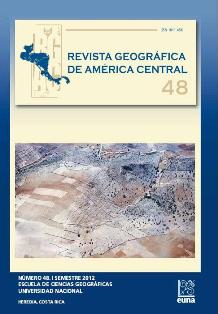AN HISTORICAL LOOK AT GEOMORPHOLOGY AND ITS ROLE AS AN APPLIED SCIENCE IN THE CONTEXT OF NATURAL HAZARDS AND LAND USE PLANNING
Keywords:
Geomorphology, natural hazards, land use planningAbstract
This article takes into consideration the historical antecedents that have contributed to the emergence of geomorphology as a science. Approaches and perspectives of some authors are inserted as a way to comment on the more relevant stages in this epistemological approach to natural hazards and their application in land use planning.
References
Anderson, M. & Burt, P. (1990). Geomorphological Techniques. Edited by
Andrew Goudie Geomorphological techniques. (Second Edition). London and New York: The British Geomorphological Research Group. p. 570
Ayala, F. y Olcina, J. (2002). Riesgos naturales. Conceptos Fundamentales y Clasificación. Editores Ayala Carcedo, F.j.; Olcina Campos, J. Riesgos Naturales. Barcelona: Editorial Ariel. pp. 41-73
George, P. (1974). Diccionario de la Geografia. Francia: Presses Universitaires de France.
Arroyo, L. N. (2008). Caracterización geomorfológica, amenazas naturales y restricciones de uso de la tierra en Esparza, Costa Rica. Un ordenamiento territorial para el Plan Regulador del cantón. En: Revista
Geográfica de América Central pp. 41- 31
Bergoeing, J. P. (1998).Geomorfología de Costa Rica. San José, Costa
Rica: Editorial Librería Francesa.
Lugo, J. (1988). Elementos de geomorfología aplicada. México: Instituto de Geografía, Universidad Autónoma de México.
Universidad de Barcelona. (1983). Positivismo y Antipositivismo en la
Ciencia Geográfica. El ejemplo de la Geomorfología. En: Cuadernos
Críticos de la Geografía Humana pp.43-12
Rodríguez, F. (2002). Metodología de la investigación histórica de desastres naturales. En: Editores Ayala Carcedo, F.j.; Olcina Campos, J. Riesgos Naturales. Barcelona: Editorial Ariel, pp. 1397-1405.
Sala, S. y Batalla, R. (1996). Teoría y métodos en geografía física. España: Editorial Síntesis.
Tricart, J. (1965). Principes et méthodes de la géomorphologie, Paris :
Masson.
Tricart, J. et Cailleux, A. (1967). Le modelé des régions périglaciaires.
Traité de géomorphologie. (tomo II). Paris : SEDES.
Tricart, J. et Cailleux, A. (1969). Le modelé des régions sèches. Traité de géomorphologie. (tome IV) Paris : SEDES.
Tricart, J. (1972). La terre planète vivante. PUF, «le géographe» section dirigée par Pierre George, pp.202.
Tricart, J. et Cailleux, A. (1974). Le modelé des régions chaudes. Forêts et savanes. Traité de géomorphologie. (Tome V). Paris : SEDES.
Tricart, J. (1977). Précis de géomorphologie.: géomorphologie dynamique générale. (Tome 2) Paris : SEDES /CDU.
Tricart, J. (1978). Géomorphologie applicable. Paris : Masson.
Tricart, J. (1981). Précis de géomorphologie. : géomorphologie climatique. ( Tome 3). SEDES Paris: CDU.
Tricart, J. et Cailleux, A. (1965). Introduction à la géomorphologie climatique. Traité de géomorphologie, (tome I). Paris: SEDES.
Vanney, J. R. (1977). Géomorphologie des plate-formes continentales. Paris : Doin.
Van Zuidam, R.(1985). Aerial photointerpretation in terrain análisis and geomorphological mapping. Smit Publishers, The Hague. The Netherlands.
Verstappen, H. (1983). Applied geomorphology, geomorphological surveys for environmental development. Enschede, The Netherlands.
ELSEVIER Amsterdam, 437 p.
International Institute for Aerial Survey and Earth Science (I.T.C.), Enschede, The Netherlands. ELSEVIER Amsterdam. pp.437.
Downloads
How to Cite
Issue
Section
License
Proposed policy for journals offering Open Access
Authors publishing their works in the Journal acknowledge and agree to the following terms:
a) Authors retain the copyrights to their works and guarantee the Journal the right to be the first to publish their works, under the Creative Commons License Attribution-NonCommercial-ShareAlike 4.0 International, CC BY-NC-SA 4.0 International (https://creativecommons.org/licenses/by-nc-sa/4.0/deed.es), which allows others to share works upon complying with the acknowledgment of authorship and mention of the Journal as the original publisher of the work.
b) Authors are permitted to separately establish additional agreements for the non-exclusive distribution of the official edition of the work published in the Journal (for example, authors may desire to place the work in an institutional repository or incorporate it into a book that is to published elsewhere) so long they acknowledgment to recognize the Journal as the original publisher. The aforementioned additional agreements must respect the terms of the non-profit character and sharing philosophy of the original license (CC BY-NC-SA 4.0 International, https://creativecommons.org/licenses/by-nc-sa/4.0/deed.es).
c) Authors are encouraged to archive the post-print or editor/PDF version in Open Access repositories.






 REVGEO is licensed under https://creativecommons.org/licenses/by-nc-sa/4.0/deed.es
REVGEO is licensed under https://creativecommons.org/licenses/by-nc-sa/4.0/deed.es
.svg_4.png)

_(1).png)
_(1)_(1)_(1)_1.png)
(2)(1)(1)(1).png)
